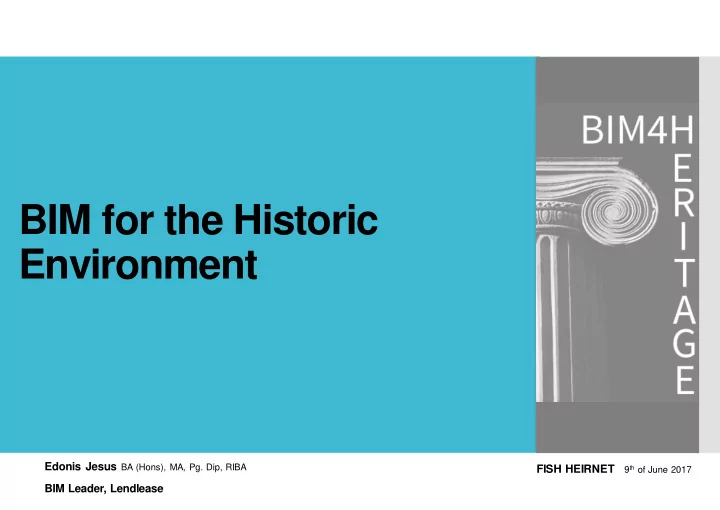

BIM for the Historic Environment Edonis Jesus BA (Hons), MA, Pg. Dip, RIBA FISH HEIRNET 9 th of June 2017 BIM Leader, Lendlease
THE CONCEPT OF BUILDING INFORMATION MODELLING (BIM) 2 Why Building Information Modelling (BIM)? 2011 1994 1998 2002 ‘Waste has been estimated to be as much as 30% of construction cost’
THE CONCEPT OF BUILDING INFORMATION MODELLING (BIM) 3 Why BIM? Reduce project risks; time, cost, quality, and safety Reduce project waste; material and efforts Increase certainty of outcomes Improve communications Increase visibility of the design and delivery processes
THE CONCEPT OF BUILDING INFORMATION MODELLING (BIM) 4 Start with the end in mind! What is BIM? BIM is … a ‘ collaborative way of working, underpinned by the digital technologies which unlock more efficient methods of designing, creating and maintaining our assets. BIM embeds key product and asset data and a 3 dimensional computer model that can be used for effective management of information throughout a project lifecycle – from earliest concept through to operation’ . Source: Autodesk Source: HM Government – Building Information Modelling - Industrial strategy : government and industry in partnership (2012)
BUILDING INFORMATION MODELLING (BIM) LEVEL 2 5 LEVEL DEFINITIONS 0- Unmanaged CAD probably 2D, With paper as the most likely data exchange mechanism 1- Managed CAD in 2 or 3D format with a collaboration tool providing a common data environment, Commercial data managed by standalone cost packages with no integration 2- Managed 3D environment held in separate discipline’s with attached data. Commercial data managed by an CDE. The approach may utilise 4D Programme data and 5D cost elements 3- Fully open process and data integration enabled by IFC or similar. Managed by a collaborative model server. Could be regarded as iBIM (integrated BIM) potentially employing concurrent engineering processes Source: PAS1192-2, 2012
THE CONCEPT OF BUILDING INFORMATION MODELLING (BIM) 6 Traditional Approach Architecture + Structure + MEP Vector based design & documentation Coordination at document level Difficult to understand the building Difficult/laborious to find clashes Difficult/laborious to coordinate internal documentation Partially resolved design & documentation
THE CONCEPT OF BUILDING INFORMATION MODELLING (BIM) 7 BIM Approach Architecture + Structure + MEP Object oriented design & documentation Coordination at model level Better understanding of the building Easier to find clashes Automatic coordination of internal documentation Enhanced coordination of design & documentation
THE CONCEPT OF BUILDING INFORMATION MODELLING (BIM) 8 Building Information Modelling
THE CONCEPT OF BUILDING INFORMATION MODELLING (BIM) 9 BIM is process and technology enabling….. • Digital representation of physical and functional characteristics • Whole life approach (concept to operation) • Consistency and standardisation • Shared knowledge • Enhanced decision making
BIM AND INFORMATION MANAGEMENT 10 VS Benefits of BIM – Information Management • Easier access to information • Improved productivity (reduced errors and omissions, reduced rework) • Improved reactive response • Improved certainty of outcomes
BUILDING INFORMATION MODELLING (BIM) FOR THE HISTORIC ENVIRONMENT 11 ‘ Understanding of any component of heritage is beyond understanding the physical characteristics of existing building, because each individual heritage object is a message from the past, and it remains as living witnesses of the age’s tradition’. (The Venice Charter, 1964)
BUILDING INFORMATION MODELLING (BIM) FOR THE HISTORIC ENVIRONMENT 12 Why BIM for the Historic Environment? • Support activities to the understanding and preservation of the historic built environment • Support CRM assessments and decision making • Support conservation, restoration, rehabilitation, repair and maintenance activities • Assist archaeological/structural analysis • Support the management of Heritage Information • Improve communication with the public - Digital representation of historic structures • Demonstrate safe methods of working, logistics planning and movement • Capture knowledge (Perceived benefits)
BIM4Heritage is a special interest group established within the BIM4Communities to champion Building Information Modelling (BIM) within the Historic Environment. The group is part of the UK BIM Alliance, which is a cross-industry alliance formed to lead BIM Level 2 and the digital formation of the construction and infrastructure sectors. Organisations involved:
BIM4Heritage Goals • Provide leadership in establishing how BIM can be used for heritage conservation, repair and maintenance processes. • Develop consistency of messaging, support and standards of BIM Implementation within the Historic Built Environment. • Provide opportunities for communicating best practice, and debating issues concerning the adoption of BIM in both private and public sectors, and with increasingly advanced applications of BIM. • Collaborate with other BIM4 Communities to advance knowledge and influence understanding in the broader context of the industry and built environment, and to initiate the culture change necessary to fully benefit from digital and information technologies and processes. • Promote historic structures BIM case studies to demonstrate best practice. • Establish collaborative links to academia. • Ensure that the group activity and outputs are coordinated and integrated with the other BIM4 community groups and CIC regional hubs.
Projects: - Development of BIM implementation guidance for asset owners -how BIM can be used for heritage conservation, repair and maintenance processes. - Define deliverables information requirements for heritage conservation, repair and maintenance processes. - Define LOD/LOI for heritage metric survey specifications/ model production. - Development of an LOD/LOI manual for multiple scenarios - Development of guidance on the combination of point cloud data and BIM geometry for the heritage sector. - Development and publishing of heritage BIM case studies - Data collection/sharing standard - Classifications specific to heritage - EIR/BEP specific to heritage
Our website: http://www.bim4heritage.org /
Events: BIM Regions – BIM for Heritage: Applying BIM to existing Buildings and Places 4th July 2017, The Skills Company, 90 Great Bridgewater Street Manchester Launch Conference 14th September 2017, Royal Academy of Arts, Burlington House, London
THANK YOU
Recommend
More recommend